If it’s world-class golf you’re after, two of the best new courses in the world lie in the north of New Zealand’s North Island. They lead the pack when it comes to our ranking of the best layouts ‘across the ditch’.
In modern golf design, great courses rarely emerge alone. Environmental and economic realities mean that new ventures are frequently mapped out with more than one great creation in mind. The environmental aspect often means that the characteristics of the land for one golf course are shared by the adjoining space, giving rise to the possibility of more than 18 holes, while the economic part can require more than one set of player traffic to be commercially viable. It’s a tremendous happenstance for the game and for golfers – a two- (or more) for-one deal that increases the enjoyment and wonder.
And so it is for New Zealand’s two leading layouts, which share the same stretch of coastline on the Hauraki Gulf where the Greater Auckland region meets Northland. In our third ranking of New Zealand’s Top 50 Courses, Tara Iti retains the top spot it held in both the two previous rankings (2016 and 2019), with its sister layout – the South course at Te Arai Links – seeing just enough play in the few months since it has been open to rank second. With the North course at Te Arai set to open this October, it’s not difficult to envisage all three new layouts occupying lofty rankings next time around.
Youth has certainly been served in New Zealand golf in recent years. Tara Iti is a mere seven years old, while Te Arai is brand new. Likewise, none of Kinloch, Kauri Cliffs, Cape Kidnappers, Jack’s Point or The Hills – all ranked in the top eight here – existed when the 1990s became the 2000s. Couple that with the additions to and renovation of Millbrook to become 36 holes and the redesign of Royal Auckland & Grange, and you have a decidedly youthful feel to the pointy end of the ranking. Yet the inherent beauty in any assessment of the best courses in New Zealand is how older, traditional layouts sit comfortably among the newer ones.

It’s this intoxicating cocktail of old and new that draws golfers from around the world. Imagine an itinerary that takes in the old-world delights of Titirangi or the quirks of Arrowtown meshing with relative newcomers like Kauri or Kinloch. Any geographic logistics aside, it’s the kind of mix that gets the pulse racing faster than a bungy jump into a Queenstown stream.
As ever, ranking lists are subjective. Thanks to COVID, our New Zealand judging panel spent an additional year compiling scores for this ranking but were just as thorough as in the past, if not more so. Use this list to plan your next venture to the Land of the Long White Cloud and there’s no chance of you returning disappointed.
Two becomes three
Public and private courses sitting adjacent is not a new thing, but operationally it is rare. Tara Iti is largely the domain of its members and will remain so, however visitors can secure a tee-time – just once – by staying in the on-site accommodation. Nowhere else in golf does the cliché “once in a lifetime” feel more real. Things are different at neighbouring Te Arai Links, though. Access is split between members and non-members and will become more defined when the North course opens. Once Te Arai has its full 36 holes open, one of the two courses will always be open to the public each day on an alternating basis. So visitors can stay for two days knowing both courses will be available to them during their two-day stay.
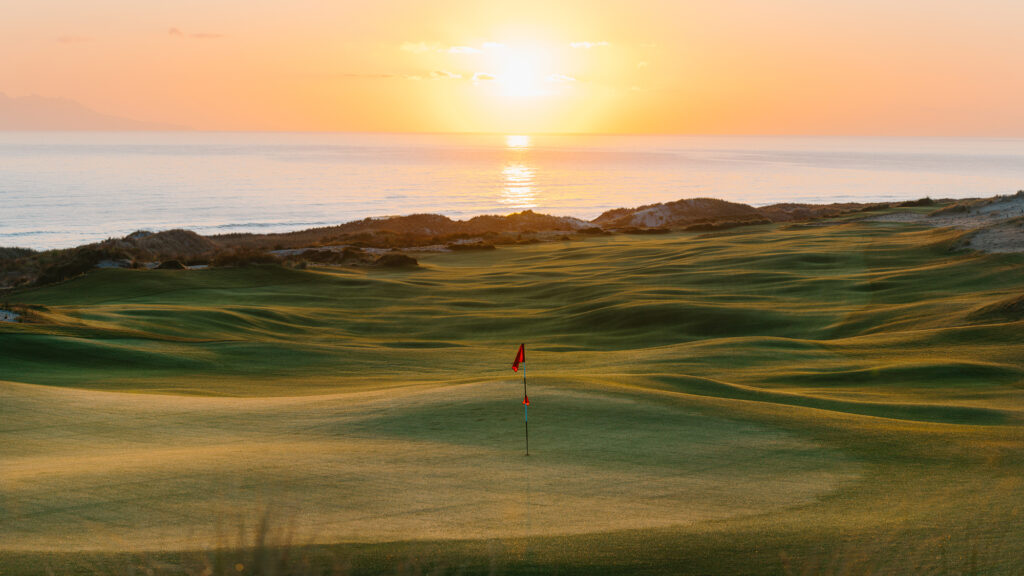
Tara Iti opened to great acclaim in 2015 and instantly became a hit for New Zealand and the South Pacific region. Tom Doak masterminded a golf course that looks even more perfect than if the land had been left untouched. Golf-wise, it’s a strategic gem – the kind of course likely to out-fox you mentally without absorbing your supply of golf balls. Doak’s layout revealed the natural undulations in the land (which was previously covered in pine trees) and used them to great effect in creating a course where the ground game rules. To catch it in the low light of the early morning or evening is to see even more character in the shapes. It’s a layout that will never become boring, such is the subtlety in the contours and the in-built variety evident in the green complexes and available pin positions.
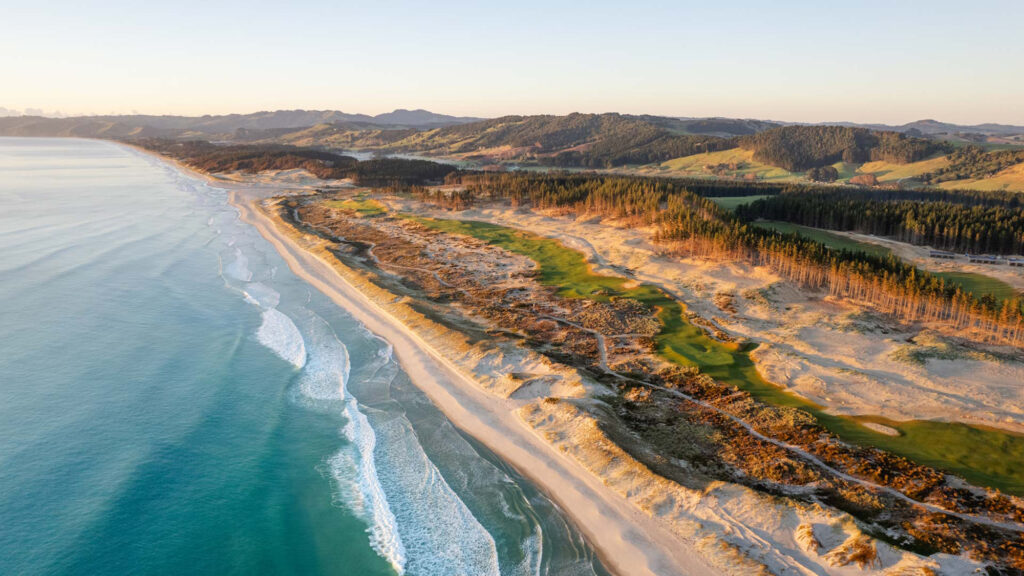
Te Arai Links sits a mere three kilometres away yet is markedly different. Bill Coore, another celebrated course architect, was chosen to pen the layout of the South course, an ideal fit for a man with a magnificent résumé of drawing great golf from such sites.
Coore recalls a lot of dune clean-up along the ocean, surmising that the government planted a lot of pine trees many years ago to stabilise the dunes. At some point a fire ripped through, so there was burnt wood and stumps that needed cleaning up. In the course-construction process, a lot of the dune vegetation disappeared and is now revegetated with flora other than marram – all approved dunes vegetation, he says.
“They don’t have cliffs there – the dunes rumble down,” Coore enthused to Australian Golf Digest last May before drawing a comparison to his other creation in this part of the world. “It’s amazing… [at Barnbougle Lost Farm] you’re much closer to the ocean but you feel much further away because of the primary dune. [Te Arai South] is more like Ireland or Scotland as there you kind of feel like you’re right on the ocean even though you’re set back from it.”
Some Tara Iti members were playing 12 holes at Te Arai on a restricted basis last autumn ahead of the full course opening last October.
Much interest, from an architectural perspective, lies in the differences between the two – and soon to be three – courses (Doak is the designer of the North course at Te Arai). Those differences are both subtle and overt, a fact noted by those closest to the broader project.
“What separates the three courses?” muses Jim Rohrstaff, managing director of Te Arai Links and Tara Iti. “The land. Even though it’s the same stretch of coast, the land is dramatically different on each property. People are stunned when they see it the first time. This summer, we’ve got a bunch of our Tara Iti members who haven’t been down here for three years – they were finally able to come back – and they’re just blown away at how different the land is. When the topography is different and the land is different, that allows them to change up the look and the aesthetics in an easier way than if it were the same crumpled dunes all over the place.”
An example is evident early in the round at Te Arai South where Coore encountered a dramatic ridgeline that he sought to incorporate into the routing. In deciding whether to go around it or over it, he called upon his considerable architectural nous. The result is that the third hole plays up the rise to a blind punchbowl target, then the fourth is a monster par 4 that cascades down the hill and around the corner.
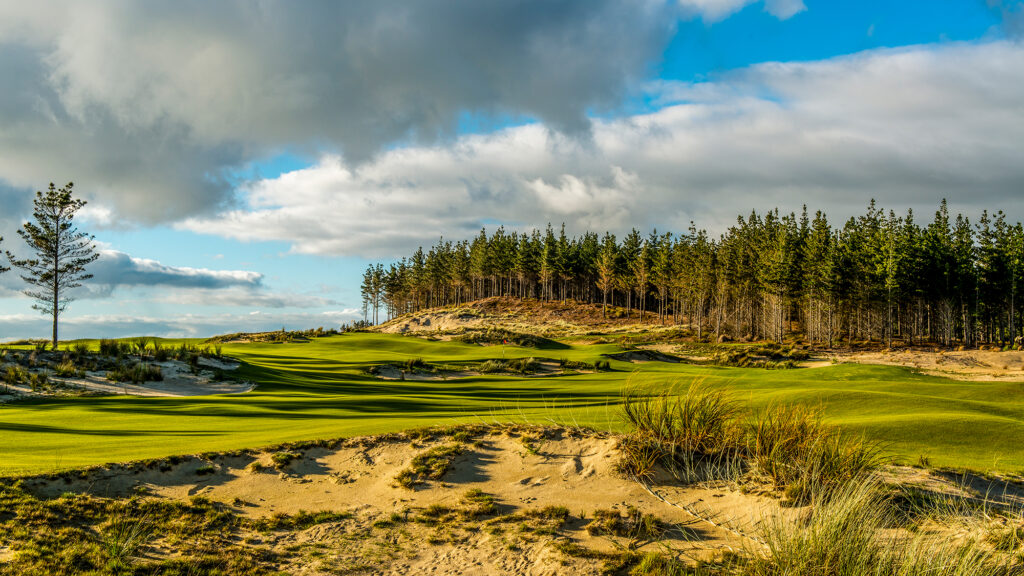
“He really navigated this huge ridgeline brilliantly,” Rohrstaff says. “He managed it in back-to-back holes, and that was his biggest piece of the puzzle with the routing – ‘How do I get over this ridgeline sensibly?’”
The elevation change is dramatic. The fourth tee is the highest part of the course, perhaps 40 metres above sea level, while the tee at the par-3 fifth is no more than 10 metres above sea level. For context, the famously downhill 10th hole at Augusta National descends approximately the same distance, 30-odd metres.
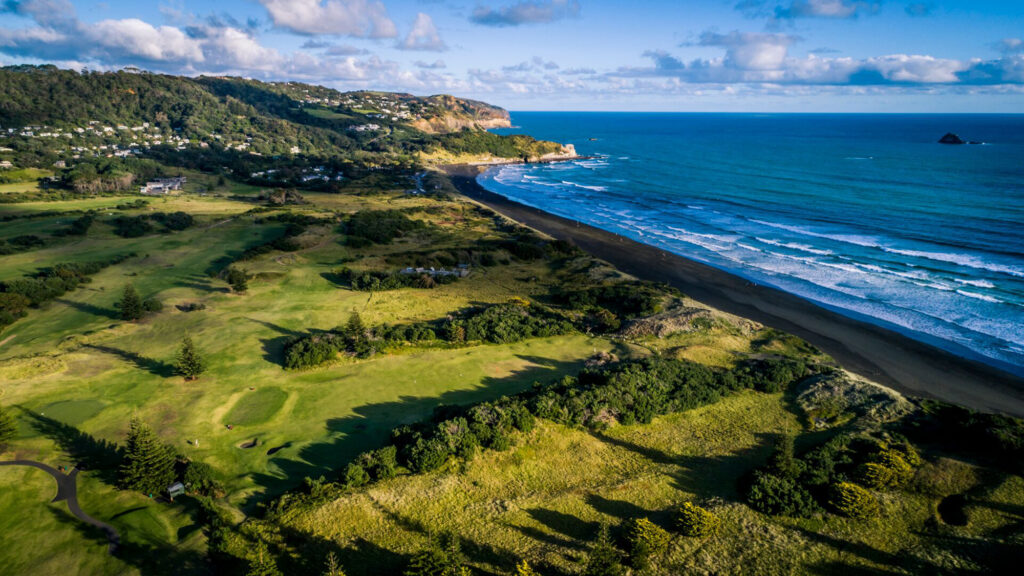
“He solved it in a way that was absolutely genius,” Rohrstaff says. “One of the biggest changes on the course was the fourth and fifth holes, from pre-reconstruction. Before, four was going to be a par 3 and then five was a par 4, and he made a last-minute change and made four a big sweeping par 4 of almost 500 yards from the back tee and made five a par 3. It was a far, far better solution. Once he said, ‘This is what we’re gonna do,’ it was like, Oh, this makes all the sense in the world, but it was not obvious at all prior to him coming out with them.”
The land is different, but the briefs given to Doak at Tara Iti and Coore at Te Arai differed only slightly. The former is a very small, very private club, so architecturally you can ‘get away with’ more. Design quirks are revered rather than maligned and elements that some might perceive to be complicated or more difficult instead have their place. “The two architects have somewhat similar philosophies and they’re called – not by themselves, but by others – minimalist in their work and the way they go about designing and their architectural style,” Rohrstaff says.
He recalls providing Doak and Coore with similar, simple briefs – written on sticky notes, of all things – comprising three bullet points. First was to create the best course in the world possible on each piece of property. Second, make it fun and fair. Lastly, it had to be a golf course where the four-hour round could be revived. Pace of play is important at Tara Iti and Te Arai, but the design aids the quest. Even an 18-handicapper or higher stands an excellent chance of not having to dip into the ball pouch of their golf bag for another sphere mid-round.

“We view Te Arai Links as our opportunity to recreate 17-Mile Drive in the Southern Hemisphere,” Rohrstaff says. “I love Pebble and Spyglass and all the courses [along that part of the California coastline]. And of course I love Cypress Point and Monterey Peninsula Country Club, but those are highly, highly private. Pebble – Pebble’s a five-and-a-half-hour round. Who wants that? So we refused to accept that that’s OK.”
While our ranking makes a decision (for 2023, at least) as to which course is superior of the two to open so far, the members’ collective take is certainly valid. The sample size will become deeper with time, and Tara Iti had the head start when it came to garnering members’ affection, yet much like the birth of a second child, the love is now falling equally.
“They love and have raved about the South course and love that it’s so much different than Tara Iti and gives them soon-to-be three courses to play,” Rohrstaff says. “Every day when they wake up and go, ‘Where do we want to play golf today?’ it’s a pretty good little group of options that we have, but they’re vastly different from one another.”
Next come the viewpoints of those who have only ventured to the region for the first time in recent months, since Te Arai South opened. Anecdotally, these fresh perspectives are close to an even split between the two courses, which will make the three-pronged decision even more interesting and intricate later this year.
“When we set out, we said to Tom and then to Bill and Ben [Crenshaw], ‘We want three courses that are distinctly different, so that somebody could play the three of them each one time, and they will never ever confuse which is which.’ But we also want them all to be good enough that they can sit down and have a burger and a beer and argue and debate over which is better and why. And if we can get anywhere close to that, we’ve hit an absolute home run. And I think that’s where we’re heading.”

Shuffles and slides
Elsewhere on the ranking, curiously, there were far more falls than rises, although few slides represented major descents. Tieke Estate, near Hamilton on the North Island, was the only other brand-new course to enter the list, doing so in 19th place. Royal Auckland & Grange returned to the ranking (in 15th) after its deliberate omission last time due to the scope of the redesign work taking place. And Millbrook officially became a 36-hole resort last year, giving it two courses on our list (11th and 20th) from now on.
The rest of the list saw mostly minor dips, driven largely by the inclusion of new and returning courses in the top 20, along with the occasional uptick. Ever-popular Paraparaumu Beach bucked the trend to leap from eighth to third, while Arrowtown and Muriwai continue to have legions of supporters, including on our judging panel.
An important section of the ranking is the part most golfers might view in a cursory fashion: the final 10. Our original list included just the 40 best layouts in New Zealand before we expanded it to the Top 50 Courses in 2019. We’ve maintained the range this time and note that, while there was movement within the 50 courses, only Whakatane on the Bay of Plenty came from outside the Top 50 in 2019 to make the 2023 list. Which isn’t to say the leading 50 are set in stone – that just happens to be the way it played out this time. The courses to fall just outside the list are absent by only small numerical margins.
It’s an exciting time in New Zealand golf. A change in prime minister hopefully means a more dedicated approach to showcasing the nation’s finest golf courses to the rest of the world. However, if that proves not to be the case, there is still no disputing the extraordinarily high calibre of golf courses from the tip of the North Island to the southern realms of the South. Golf in New Zealand has so much to offer and a magnificent collection of courses about which to feel immensely proud.
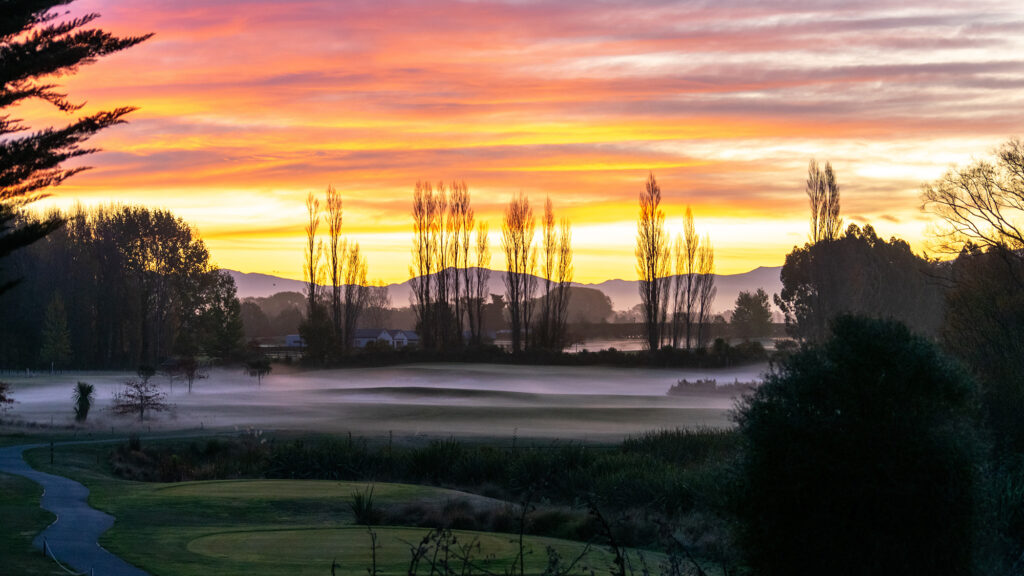
How the ranking was compiled
Our judging panel visits and scores courses using seven criteria:
Shot Options (score out of 20): How well does the course present a variety of options involving risks and rewards and require a wide range of shots?
Challenge (out of 10): How challenging, while still being fair, is the course for a typical scratch golfer playing from the tees designated as back tees for everyday play (not from seldom-used championship tees)?
Layout Variety (out of 10): How varied is the physical layout of the course in terms of differing lengths (long, medium and short par 3s, 4s and 5s), configurations (straight holes, doglegs left and right), hazard placements, green shapes and green contours?
Distinctiveness (out of 10): How individual is each hole when compared to all others on this course? Additionally, how fun and enjoyable for all levels of golfers would this course be to play on a regular basis?
Character (out of 10): How well does the course design exude ingenuity and uniqueness and possess profound characteristics that you would consider outstanding for its era?
Aesthetics (out of 10): How well do the scenic values of the course (including landscaping, vegetation, water features and backdrops) add to the pleasure of a round?
Conditioning (out of 10): How firm, fast and rolling were the fairways? How firm yet receptive were the greens? How true were the rolls of putts?
To arrive at a course’s final score, we total its averages in the seven categories, doubling Shot Options to create a score out of 80.
For their time and input, we thank our panel of judges: Scott Ball, Ginny Bolderston, Steve Brent, Bob Brereton, Geoff Burns, Ian Charlton, Terry Cochrane, Dan Crook, Paul Dunn, Ray Ellis, Ryan Green, Nicholas Healy, Tolan Henderson, Raymond Hinton, Macaulay Howell, Chris Hunt, Andrew Jackson, Regan Johnston, Ray Jones, Erik Jorgensen, Loren Justins, Devon Kay, Steve Keipert, William Leipnik, Kerry Manderson, Regan McCaffery, Richard Middleton, John Murcott, William Owen, James Pearson, Gerald Ponsford, Mike Reid, David Ross, Tim Ross, Dave Saunders, Andrew Sloane, Jonathan Smith, Mike Smith, Tom Starr, Mike Wharepouri, Anaru White, Adam Williams and Brendon Williams, along with Ryan Brandeburg who assisted in a non-voting capacity.


*Millbrook didn’t have 36 holes in 2019 when just the premier 18 holes was considered (and ranked ninth).
**Royal Auckland & Grange was intentionally omitted last time, due to the scope of the redesign work taking place at the time.
Whakatane came from outside the Top 50 in 2019 to make the 2023 list.



